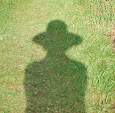Ishbel's class had a Titanic exhibition and stage production today at school.
It was absolutely terrific. They had their class work on show which illustrated all the various topics that can be incorporated into classroom learning: geography (UK - America travel), temperature (ice in water), social class (different types of passengers), ship-building, and they even looked at possible reasons for why the disaster happened. Ishbel, some months ago, gave us a thorough description of hull rivets and the nature of the impact of the ice ... And she is only 9 years old!
Watching their stage presentation I learned that radio operators on the Titanic sent out the signal to ships who might be in the area the Morse Code signal CQD. 'CQD'? I had never heard of this.
THE HISTORY OF THE DISTRESS SIGNAL SOS
The commonly known word used for "I'm in trouble", in my experience, was SOS.
(At sea Mayday is used for "Help" [“mayday” came into use in the 1940s because it sounded like the French word m'aider, which means “help me.”]. and "Pan Pan for "I have a problem but I am not sinking." ... but leave that aside for the now.)
CQD, transmitted in Morse code as – · – · – – · – – · · is one of the first distress signals adopted for radio use. It was announced on 7 January 1904, by "Circular 57" of the Marconi International Marine Communication Company, and became effective, beginning 1 February 1904 for Marconi installations.
Land telegraphs had traditionally used "CQ" ("sécu", from the French word sécurité[1]) to identify alert or precautionary messages of interest to all stations along a telegraph line, and CQ had also been adopted as a "general call" for maritime radio use. However, in landline usage there was no general emergency signal, so the Marconi company added a "D" ("distress") to CQ in order to create its distress call. Thus, "CQD" is understood by wireless operators to mean, "All stations: distress." Contrary to popular belief, CQD does not stand for "Come Quick, Danger", "Come Quickly: Distress", "Come Quick—Drowning!", or "C Q Danger" (Seek You, Danger)....
Land telegraphs had traditionally used "CQ" ("sécu", from the French word sécurité[1]) to identify alert or precautionary messages of interest to all stations along a telegraph line, and CQ had also been adopted as a "general call" for maritime radio use. However, in landline usage there was no general emergency signal, so the Marconi company added a "D" ("distress") to CQ in order to create its distress call. Thus, "CQD" is understood by wireless operators to mean, "All stations: distress." Contrary to popular belief, CQD does not stand for "Come Quick, Danger", "Come Quickly: Distress", "Come Quick—Drowning!", or "C Q Danger" (Seek You, Danger)....
Although used worldwide
by Marconi operators, CQD was never adopted as an international
standard, since it could be mistaken for a general call "CQ" if the
reception were poor.[citation needed] At the second International
Radiotelegraphic Convention, held in Berlin in 1906, Germany's
Notzeichen distress signal of three-dots/three-dashes/three-dots (· · · –
– – · · · ) was adopted as the international Morse code distress
signal. (This distress signal soon became known as "SOS". Germany had
first adopted this distress signal in regulations effective 1 April
1905.)[citation needed]
In April 1912, RMS Titanic radio operator Jack Phillips initially sent "CQD", which was still commonly used by British ships. Harold Bride, the junior radio operator, jokingly suggested using the new code, "SOS". Thinking it might be the only time he would get to use it, Phillips began to alternate between the two.
In April 1912, RMS Titanic radio operator Jack Phillips initially sent "CQD", which was still commonly used by British ships. Harold Bride, the junior radio operator, jokingly suggested using the new code, "SOS". Thinking it might be the only time he would get to use it, Phillips began to alternate between the two.








No comments:
Post a Comment